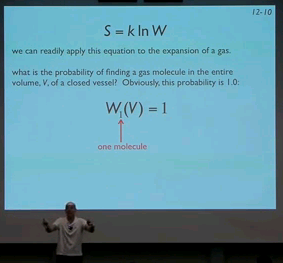UCI Chem 131C Thermodynamics and Chemical Dynamics (Spring 2012)
Lec 12. Thermodynamics and Chemical Dynamics -- Entropy and The Second Law --
View the complete course: ../courses/chem_131c_thermodynamics_and_chemical_dynamics.html
Instructor: Reginald Penner, Ph.D.
License: Creative Commons BY-NC-SA
Terms of Use: ../info.
More courses at http://ocw.uci.edu
Description: In Chemistry 131C, students will study how to calculate macroscopic chemical properties of systems. This course will build on the microscopic understanding (Chemical Physics) to reinforce and expand your understanding of the basic thermo-chemistry concepts from General Chemistry (Physical Chemistry.) We then go on to study how chemical reaction rates are measured and calculated from molecular properties. Topics covered include: Energy, entropy, and the thermodynamic potentials; Chemical equilibrium; and Chemical kinetics. This video is part of a 27-lecture undergraduate-level course titled "Thermodynamics and Chemical Dynamics" taught at UC Irvine by Professor Reginald M. Penner.
Thermodynamics and Chemical Dynamics (Chem 131C) is part of OpenChem: ../openchem/
Recorded on April 30, 2012.
Index of Topics:
00:09 - Introduction
01:02 - Announcements
02:11 - where are we (chapter and timeline)?
04:00 - 1st Law: Energy is conserved for an isolated system ΔU = 0.
05:32 - Coin Experiment
06:35 - experiment: conclusion (the most important one so far)
06:51 - Boltzmann postulated that this parameter
07:11 - We can readily apply this equation to this expansion of gas.
08:11 - Now, what is the probability that...
09:05 - Problem: Gas A and Gas B are located in two halves of a container
13:07 - What if instead of the change in entropy...
13:33 - Formula (S =)
14:09 - Calculate the standard molar entropy of neon gas at (a) 200K, (b) 298.15K.
15:53 - Sadi Carnot
17:54 - match the scientist with his country
18:44 - entropy
19:28 - the Carnot Cycle
21:00 - A heat engine extracts work from a temperature gradient
21:41 - The Carnot Cycle (graph)
23:31 - what do we know for sure? (graph continued from Carnot Cycle)
24:18 - how efficient is a heat engine?
25:10 - efficiency (slide at 24:18 continued)
26:24 - how efficient is a Carnot Cycle?
27:28 - let's prove this:
27:52 - now, this pair of (T,V) data points lie on an adiabat:
29:55 - Problem: A heat pump is used to maintain the temperature of a building at 18°C...
32:03 - Problem: What is the entropy change, ΔS, for each of the four steps as a reversible Carnot cycle
32:31 - Diagram: Since S is a state function, we can write:
33:50 - so we represented in a Temperature-Entropy diagram...
34:48 - Since S is a state function, we can write:
Required attribution: Penner, Reginald Thermodynamics and Chemical Dynamics 131C (UCI OpenCourseWare: University of California, Irvine), ../courses/chem_131c_thermodynamics_and_chemical_dynamics.html. [Access date]. License: Creative Commons Attribution-ShareAlike 3.0 United States License.



